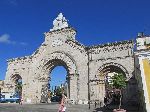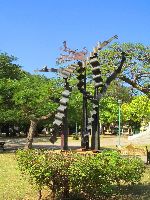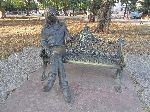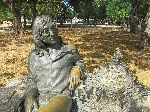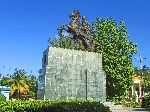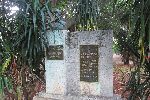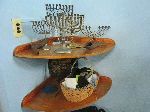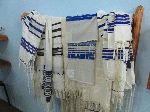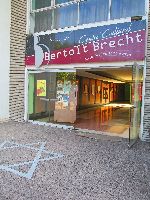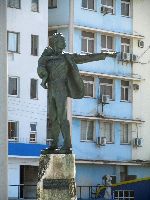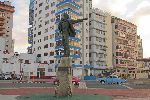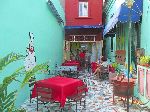| . | ||
Cuba
|
||
Vedado, Havana |
||
|
Vedado is sometimes referred to as the capital of the Capital. In a fairly small area it provides insight into; architecture (residential and commercial), land use patterns (park boulevard, parks, residential and commercial), public institutions (schools, hospitals (at least eight, including cardio and oncology)), religious institutions (churches, convents and a synagogue), monuments and statues (John Lennon, socialist world leaders, military, politician, intellectuals, Jose Marti) and transportation. It is also interesting what is prevalent (micro-stops, cafeterias, restaurants, creameria and cinemas (Calle 23 has six)). And what is absent (consumer tienda / bodega / stores; boutiques, cell phone stores, chain stores, etc.) |
||
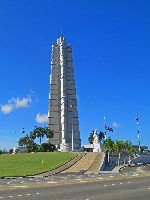 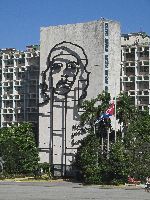 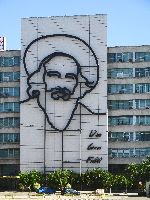 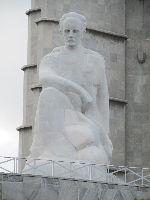 One of the best know landmarks in
Vedado is Plaza de la Revolución (Revolution Square). It exists because of a monument to
José Marti, which predates the 1959 revolution, but perhaps more recognizable
are the sculptures of Ernesto "Ché" Guevara (1928-1967) and Camilo
Cienfuegos (1932-1959) that are attached to government building. Both Ché
and Cienfuego are revolutionary figures who were
with Fidel Castro from the start of the revolution in 1956. Both are dead
and both are martyrs, but Ché Guevara brand lives on with the
sales of a multitude of products with his face on them. Ché's face is known
all over the world, and is the face of the revolution. One of the best know landmarks in
Vedado is Plaza de la Revolución (Revolution Square). It exists because of a monument to
José Marti, which predates the 1959 revolution, but perhaps more recognizable
are the sculptures of Ernesto "Ché" Guevara (1928-1967) and Camilo
Cienfuegos (1932-1959) that are attached to government building. Both Ché
and Cienfuego are revolutionary figures who were
with Fidel Castro from the start of the revolution in 1956. Both are dead
and both are martyrs, but Ché Guevara brand lives on with the
sales of a multitude of products with his face on them. Ché's face is known
all over the world, and is the face of the revolution. |
||
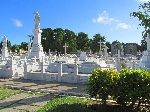
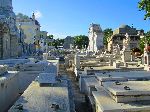
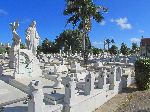
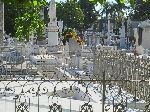
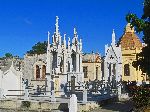 |
||
|
The
most interesting destination in Vedado is the Necropolis Cristobal Colon
(1868). It is also considered to be one of the greatest historical cemeteries in
the world. Because it is so interesting and extensive, we have created a
special section on Colon cemetery to tell some of its
stories. We encourage you to visit it.
A contemporary of Loira, and renown Cuban sculptor José Vilalta de Saavedra created the Virtues (Faith, Hope and Charity) above the main gate - a trio of giant Romanesque-Byzantine arches that lead the way into a broad, tree-lined avenue - and the religious relief sculptures around the cemetery walls. One aspect of the cemetery that makes it so interesting, and hardly gloomy, it is thick with symbolism, history, irony and humor. |
||
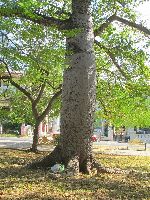 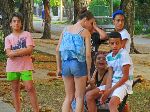 An
old tree grows John Lennon Park. It is a cieba tree (Bombacoideae),
which is favored by the practitioners of the Afro-Cuban religion Santeria.
Note the offerings at the base of the tree. An
old tree grows John Lennon Park. It is a cieba tree (Bombacoideae),
which is favored by the practitioners of the Afro-Cuban religion Santeria.
Note the offerings at the base of the tree.
Back in the day when this was Calle 6 Park, no one cared about it except the neighborhood kids. They still come. What is new, since the installation of a bronze sculpture of John Lenin,
sculpted by Cuban artist José Villa Soberón, is the park has become a major
pilgrimage for Northern tourists. The very existence of the statue is a bit
ironic as that the Beatles and their music were banned in Cuba after
the revolution in the 60-70's. Now there is a statue honoring one of
them. What is even more ironic is that Fidel Castro inaugurated it himself
in December 8, 2000. Twenty years after his death. The statue is complete with Lennon's iconic wire rim glasses. These have
lead to some mystic, because the glasses kept being broken off, vandalized
and stolen. There is now an attendant for the statue who puts the glasses on
Lennon, and takes them off, depending upon whether he has any visitors. There is also another, much larger, sculpture in the park, an abstract installation said to be a dancer (right), and said to be a commission by Yoko Ono. |
||
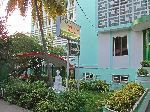
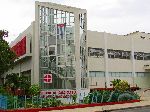
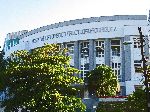
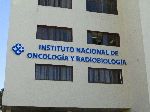
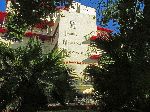 |
||
| Around the corner from Lennon Park is the Hospital de Obstetricia y Ginecologia. But this is just one of at least eight specialty hospital and medical institutes in Vedado. Among the others are: Instituto de Cardiologia y Cirugia Cariovascular, Hospital Orthopedico Fructuoso Rodriguez, Institututo Nacional de Oncologia y Radiobiologia, and Instituto Neurologia Neurocirugia. The Cubans we met who have been treated or have had family members treated at these facilities have high praise for them. | ||
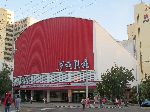
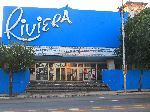
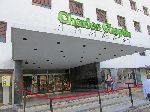
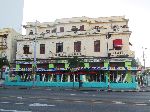
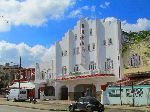 |
||
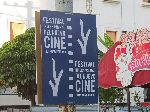 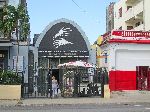 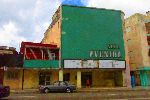 And,
not to be out done, there are at least six cinemas in Vedado, mostly on
Calle 23. Elsewhere in Havana, there another twenty-plus open cinemas, and
118 theaters that have closed. And,
not to be out done, there are at least six cinemas in Vedado, mostly on
Calle 23. Elsewhere in Havana, there another twenty-plus open cinemas, and
118 theaters that have closed.
Another measure of the health of film in Havana is the annual Festival Internacional del Nuevo Cine Latino Americano, in mid-December. There are often lines outside the theaters. Cubans are big movie buffs and support a wide range of film genre. Centro Cultural Cinematografico del ICAIC specializes in video presentations of cult movies. |
||
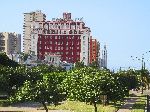 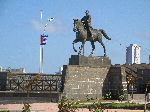 If
Colon Cemetery isn't sufficient the next items that Vedado has and abundance
of is statues. Many of this are on Avenida de los Presidentes and the Malecón.
The lower part of the Avenida is dominated by the Hotel Presidente. At the
junction of the Avenida and Malecón is
Monumento a Calixto Garcia. Born in
Holguin, into a progressive family. He has a statue because he was a
general in three Cuban uprisings, part of the Cuban War for Independence:
Ten Years' War, the Little War and the War of 1895, itself sometimes called
the Cuban War for Independence, which bled into the Spanish–American War,
ultimately resulting in national independence for Cuba. If
Colon Cemetery isn't sufficient the next items that Vedado has and abundance
of is statues. Many of this are on Avenida de los Presidentes and the Malecón.
The lower part of the Avenida is dominated by the Hotel Presidente. At the
junction of the Avenida and Malecón is
Monumento a Calixto Garcia. Born in
Holguin, into a progressive family. He has a statue because he was a
general in three Cuban uprisings, part of the Cuban War for Independence:
Ten Years' War, the Little War and the War of 1895, itself sometimes called
the Cuban War for Independence, which bled into the Spanish–American War,
ultimately resulting in national independence for Cuba. |
||
| Statues continue, every couple of blocks, up the median of Avenida de los Presidentes (reflection of political values and culture). | ||
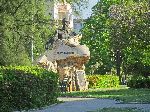
José Eloy Alfaro Delgado (left) served as President of Ecuador from 1895 to
1901 and from 1906 to 1911. His major legacies are considered to be national
unity, and the integrity of Ecuador's borders; the increased secularization
of the country; and the modernization of Ecuadorian society through the The horseman is Simon Bolivar (24 July 1783 – 17 December 1830). He is recognized for his leading role in the establishment of sovereign states, independent of Spanish colonial rule. His efforts lead to the independence of Venezuela, Bolivia, Colombia, Ecuador, Peru, and Panama. |
||
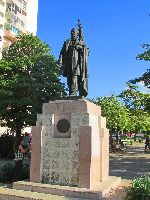 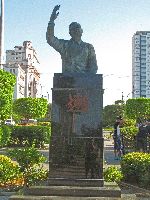 Benito
Juarez Garcia (left) served as the president of Mexico for five terms: 1858–1861
as interim, then 1861–1865, 1865–1867, 1867–1871 and 1871–1872 as constitutional
president. He is remembered as being a progressive reformer dedicated to
democracy, equal rights for his nation's indigenous peoples, his antipathy
toward organized religion, especially the Catholic Church (motivated by his
adherence to Freemasonry), and what he regarded as defense of national
sovereignty. Benito
Juarez Garcia (left) served as the president of Mexico for five terms: 1858–1861
as interim, then 1861–1865, 1865–1867, 1867–1871 and 1871–1872 as constitutional
president. He is remembered as being a progressive reformer dedicated to
democracy, equal rights for his nation's indigenous peoples, his antipathy
toward organized religion, especially the Catholic Church (motivated by his
adherence to Freemasonry), and what he regarded as defense of national
sovereignty.Salvador Allende (right) was a Chilean physician and politician. He is best known as the first Socialist to become president, in 1970, of a Latin American country through open elections. Three years later, the military moved to oust Allende in a coup d'état sponsored by the United States Central Intelligence Agency. |
||
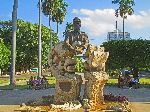 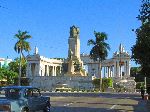 Omar Torrijos (left) was the Commander of the Panamanian and National Guard and the de facto dictator of Panama from 1968 to 1981. Torrijos was never officially the president of Panama, but instead held titles including "Maximum Leader of the Panamanian Revolution" and "Supreme Chief of Government." Torrijos took power in a coup d'état and instituted a number of social reforms and his regime was considered progressive. José Miguel Gómez (1858-1921) (right) was born in Sancti Spiritus. He was a Cuban general in the War of Independence and later became the second President of Cuba. He also fought against the Spanish in the Ten Years' War, and the Little War. Gómez was viewed as a kind president in the eyes of the people. However, political corruption boomed during his presidency and several major scandals occurred. |
||
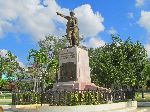
Mariana Grajales Coello (left) (1808 – 1893) is a Cuban icon of the women's
struggle and the fight for an independent Cuba free from slavery. Mariana and
her family served in the Ten Years' War, Little War (1868-1878) and the War of
1895. Jose and Antonio Maceo Grajales, sons of Mariana, served as generals in
the Liberation Army from 1868 through 1878. During her time serving in the war,
Mariana ran hospitals and provision grounds on the base camps of her son
Antonio, frequently entering the battlefield to aid wounded soldiers, both
Spaniard and Cuban. José Martí, after witnessing Mariana Grajales and Antonio
Maceos' wife, Maria Cabrales, enter the battlefield to rescue the wounded
Antonio, Francisco Pi y Marcall (right) was a Spanish politician, Catalan federalist and libertarian socialist statesman, Mason, historian, and political philosopher and romanticist writer. He was briefly president of the short-lived First Spanish Republic in 1873. |
||
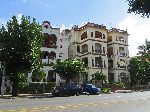
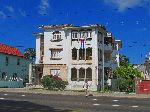

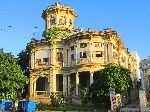
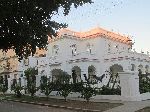 |
||
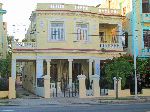 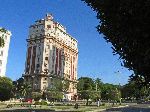 Vedado
is primarily residential and relatively affluent, on a Cuban scale, so
looking at where people are living is part of a walk on every block. Unless
you can get inside you really can't get the whole story. Many of the mansion
were divided up after the revolution so a "house" might be shared by several
family, each taking a floor. Or if it is big enough a floor could be divided
for two families. From the different building materials and window, the
building to the rights looks like there was an original eight story
building, and then addition construction projects to add top floors twice. Vedado
is primarily residential and relatively affluent, on a Cuban scale, so
looking at where people are living is part of a walk on every block. Unless
you can get inside you really can't get the whole story. Many of the mansion
were divided up after the revolution so a "house" might be shared by several
family, each taking a floor. Or if it is big enough a floor could be divided
for two families. From the different building materials and window, the
building to the rights looks like there was an original eight story
building, and then addition construction projects to add top floors twice. |
||
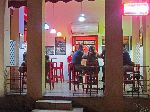
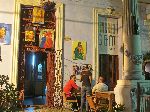
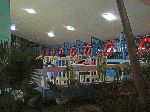
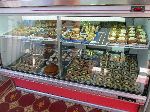
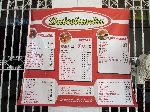 |
||
| Where there are people, it is often a good place to find restaurants. But the story here is between state restaurants and "paladars" (private restaurants). State restaurants can be subsidized and have lower prices, but they also have a reputation for horrible service and dreary ambiance. It is pretty easy to see on an evening stroll down Avenida 23. The private restaurants (above) have much more al fresco seating, and someone has pushed for fresher and brighter paint job and decorations, and more attentive wait staff. Besides having fewer guest, the state restaurants (three images, below left) lacked much cheerfulness. | ||
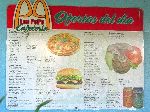 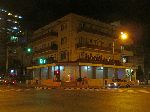
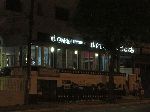
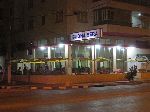 The menu (right) garnered attention because of its logos similarity to golden
arches. They are actually double-P's, for Pepe. The menu (right) garnered attention because of its logos similarity to golden
arches. They are actually double-P's, for Pepe. |
||
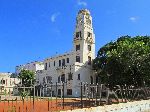 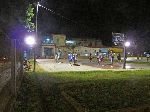 There
are primary and middle schools (left) scattered around Vedado. The middle school
got a second look because it looks like it has been repurposed from the original
architecture. There
are primary and middle schools (left) scattered around Vedado. The middle school
got a second look because it looks like it has been repurposed from the original
architecture.I can say whether it is because the temperature is cooler, or the players are off work and have time for recreation, but the time the basketball court came alive was in the evening. |
||
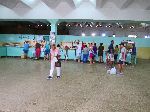 Basic nutrition is part of Cuba's social safety net (along with virtually free,
health, housing, drinking water, electricity and education.) As part of the
nutrition program every Cuban receives a booklet which authorizes a heavily
subsidized, weekly or monthly
allotment of foodstuffs like rice, beans, pork, eggs, milk, potatoes, tomatoes,
oil, sugar, coffee and other items, through a special distribution network. The shops
distributing these items don't portend to be supermarkets, with six brands of
corn flake, and much of their inventory is in bulk, so they look quite
stark - and are self-conscious about being photo graphed. The allotment
varies by age, gender and health status. Special attention is given to children,
pregnant women and the elderly. The system, modeled after one in the Soviet
Union, was adopted 1962 as a temporary palliative to a crisis. It has lasted for
more than fifty years. There have always been supporters and critics of the
justice of the system. There is now a trend to reduce the number
of items that are distributed through this system.
Basic nutrition is part of Cuba's social safety net (along with virtually free,
health, housing, drinking water, electricity and education.) As part of the
nutrition program every Cuban receives a booklet which authorizes a heavily
subsidized, weekly or monthly
allotment of foodstuffs like rice, beans, pork, eggs, milk, potatoes, tomatoes,
oil, sugar, coffee and other items, through a special distribution network. The shops
distributing these items don't portend to be supermarkets, with six brands of
corn flake, and much of their inventory is in bulk, so they look quite
stark - and are self-conscious about being photo graphed. The allotment
varies by age, gender and health status. Special attention is given to children,
pregnant women and the elderly. The system, modeled after one in the Soviet
Union, was adopted 1962 as a temporary palliative to a crisis. It has lasted for
more than fifty years. There have always been supporters and critics of the
justice of the system. There is now a trend to reduce the number
of items that are distributed through this system. |
||
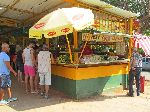 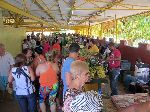
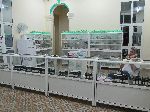 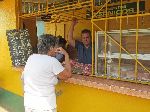 Since
the special period, and even more so since Raul assumed the presidency, the
private sector of the economy has been loosening up. "Free markets" or "parallel
markets" where producers sell directly to the public, are now common place.
Depending upon the season and location, a wide variety of vegetables, fruits,
grains and meat is available in the market. There seems to be plenty of supply
in these markets. There is also a black market. Black market goods may be simply
items sold by unlicensed vendors (for example, fish caught and sold directly, or
home-made items), or may be stolen goods. There is also bartering. Since
the special period, and even more so since Raul assumed the presidency, the
private sector of the economy has been loosening up. "Free markets" or "parallel
markets" where producers sell directly to the public, are now common place.
Depending upon the season and location, a wide variety of vegetables, fruits,
grains and meat is available in the market. There seems to be plenty of supply
in these markets. There is also a black market. Black market goods may be simply
items sold by unlicensed vendors (for example, fish caught and sold directly, or
home-made items), or may be stolen goods. There is also bartering. |
||
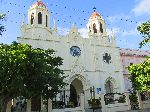
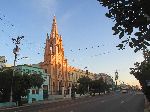 Iglesia
y Convento de Santa Catalina de Siena and Residencia San Juan María Vianney de La Habana (left). Iglesia
y Convento de Santa Catalina de Siena and Residencia San Juan María Vianney de La Habana (left).Church on Avenida 23 (right) |
||
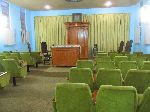
Centro Sefaradi has an old and new building. The old building is a history exhibit. The new building houses offices and the new sanctuary, with it rack of tallit (prayer shawls) and shelves of ritual items. |
||
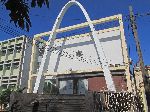 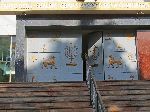 Beth Shalom is probably the largest and most progressive congregation in Havana. It's doors are interesting for the number of symbols they display.
A blurb for the Café Teatro reads: "has a number of attractions including No Se Lo Digas a Nadie (Don’t tell anyone!) nights which features some of the best contemporary Cuban musicians in an MTV’s unplugged scenario. This has an Art Nouveau feel to it and is a relaxed (and cheap) place to take the heat out of the day. On nights when there is a band expect the bar to be packed with a cool young Cuban contingent. This is a place to meet young twenty-something Cuban partygoers." |
||
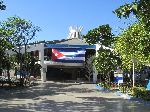 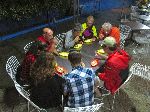 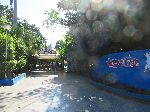 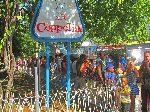 On
the subject of religion, there is the near religion of Coppelia, Havana's most famous ice cream
cathedral and a regular pilgrimage for family outings and date-night. It has a seating capacity of hundreds, but still, on Friday night and
all day on weekends, there can be long lines waiting to be seated. The secret
for quick service is to go on a rainy night. On
the subject of religion, there is the near religion of Coppelia, Havana's most famous ice cream
cathedral and a regular pilgrimage for family outings and date-night. It has a seating capacity of hundreds, but still, on Friday night and
all day on weekends, there can be long lines waiting to be seated. The secret
for quick service is to go on a rainy night. |
||
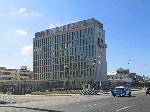 A
few blocks northwest of Coppelia, on the Malecón (sea wall)
is the American Embassy, formerly the US Interest Section. The cynic would
observe that it is set on the piece of land in
Cuba that is the absolute closest to Dry Tortugas National Park, USA, off Key West.
Maybe the planners figured that if there was a major problem the staff could
run across the street, jump in the ocean and swim for it. The speculation is
discredited by 1953 dedication of the building. Most comments about
the American Embassy tend to focus its scale and architecture. A
few blocks northwest of Coppelia, on the Malecón (sea wall)
is the American Embassy, formerly the US Interest Section. The cynic would
observe that it is set on the piece of land in
Cuba that is the absolute closest to Dry Tortugas National Park, USA, off Key West.
Maybe the planners figured that if there was a major problem the staff could
run across the street, jump in the ocean and swim for it. The speculation is
discredited by 1953 dedication of the building. Most comments about
the American Embassy tend to focus its scale and architecture.Relations with Cuba were severed and the embassy closed in 1961. It was reopened as the United States Interest Section in 1977, during the Carter administration, but was not permitted to fly the flag. It regained its status as the United States Embassy in 2015, during the administrations of Barak Obama and Raul Castro. |
||
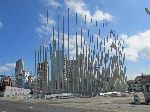 Tribuna
Antiimperialista José Martí is a public event venue located in the Plaza de
la Dignidad, across the street, to the east, from the U.S. Embassy. It was
opened in April 2000. The first demonstration were in support of the return of
Elián González, a six year old boy at the time, who was being held by relatives
in Havana. His father was in Cuba. Tribuna
Antiimperialista José Martí is a public event venue located in the Plaza de
la Dignidad, across the street, to the east, from the U.S. Embassy. It was
opened in April 2000. The first demonstration were in support of the return of
Elián González, a six year old boy at the time, who was being held by relatives
in Havana. His father was in Cuba.
In keeping with the fluidness of conditions in Cuba, a stage and arches were setup in the middle of the Plaza in early 2005, for a May concert by the American rock band Audioslave. It is considered to be the first outdoor rock and roll concert on Cuban soil by an American band. The capacity of the plaza was an impressive 60,000 for that free concert. |
||
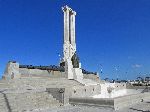 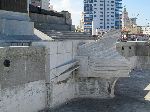 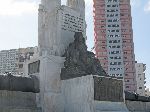 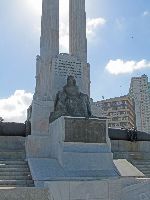 East
along the Malecón, from the U.S. Embassy, is the Monument to the Maine.
It was
inaugurated March 8, 1925 and includes two of the ship's 10 inch guns. It's
in memory of the lives lost in the Maine disaster that took place on
February 15, 1898 in Havana harbor. The incident was portrayed as an attack
and used as a rational to attack Spain (the Spanish-American War, fought in Cuba
and the Philippines). Subsequent research found that the explosion was more
likely human error on the part of the personnel working on the board. East
along the Malecón, from the U.S. Embassy, is the Monument to the Maine.
It was
inaugurated March 8, 1925 and includes two of the ship's 10 inch guns. It's
in memory of the lives lost in the Maine disaster that took place on
February 15, 1898 in Havana harbor. The incident was portrayed as an attack
and used as a rational to attack Spain (the Spanish-American War, fought in Cuba
and the Philippines). Subsequent research found that the explosion was more
likely human error on the part of the personnel working on the board. |
||
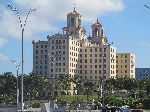
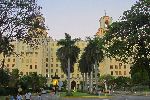
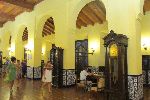
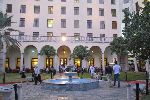
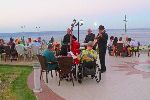 |
||
| On the hill above the Maine Monument is the luxury National Hotel. It was completed in 1930. Like a number of distinctive building it incorporates a mix of styles including Sevillian, Roman, Moorish and Art Deco. As an old impressive hotel, it has hosted a long list of prominent guests, and being in Havana, it has as a part of its history coups, mob summits, Jim Crow policies, casino magnates, the reversal of Cuban politics, and the Cuban Missile Crisis. The photo, above, left to right, are the profile, the entrance, the lobby, the back garden and the patio overlooking the Malecón and Havana Bay. For a little extra intrigue, the hotel was built on the site of a artillery battery from 1797. Part of the battery has been preserved in the hotel's gardens, including two large coastal guns dating from the late 19th Century. | ||
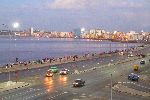 Malecón
is the seawall along the Bay of Havana, but it is also the name for the road
that follows the seawall. The seawall is a very popular place for people,
especially young people to gather and sit. Older people tend to be more inclined
to promenade along the wide sidewalk. Though there is a major challenge with
this design. The road can be six or more lanes wide, and can have heavy traffic
in both directions for many hours - less than people friendly. Malecón
is the seawall along the Bay of Havana, but it is also the name for the road
that follows the seawall. The seawall is a very popular place for people,
especially young people to gather and sit. Older people tend to be more inclined
to promenade along the wide sidewalk. Though there is a major challenge with
this design. The road can be six or more lanes wide, and can have heavy traffic
in both directions for many hours - less than people friendly. |
||
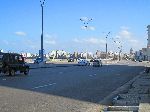
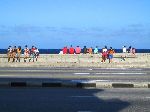
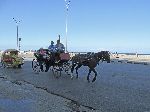
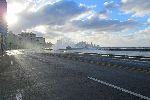
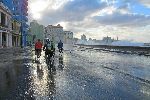 |
||
| If you happen to come by when the waves are cresting the seawall, which happens with some regularity (and might get more frequent), they close the road to motor vehicle traffic. It is not such a good environment for sitting on the seawall, but if conditions are not too extreme the authorities let bikes pass. (There are very few bikes lined up at the ready because usually the road is pretty unwelcoming to bicyclists.) You have your choice of any of the six lanes, but plan on a good rinse of the bike at the end of the ride because all of the standing water and spray is fresh from the sea. | ||
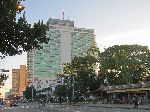 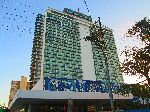 A
few blocks east of the National is the Habana Libre Hotel, built as the Habana
Hilton, and opened in March 1958. Following the entry of Fidel Castro into
Havana, on January 8, 1959, the hotel became his headquarters for 3 months. He
took the suite 2324 as his central office. In October 1960, all American hotels
in Cuba were nationalized and the casinos permanently closed. After 35 years
without a lot of highlights, the hotel was renovated between 1996 and 1997.
Among the highlights of the work was the restoration of an enormous original
mural by artist Amelia Peláez over the main entrance which had spent decades
hidden from public view. A
few blocks east of the National is the Habana Libre Hotel, built as the Habana
Hilton, and opened in March 1958. Following the entry of Fidel Castro into
Havana, on January 8, 1959, the hotel became his headquarters for 3 months. He
took the suite 2324 as his central office. In October 1960, all American hotels
in Cuba were nationalized and the casinos permanently closed. After 35 years
without a lot of highlights, the hotel was renovated between 1996 and 1997.
Among the highlights of the work was the restoration of an enormous original
mural by artist Amelia Peláez over the main entrance which had spent decades
hidden from public view. |
||
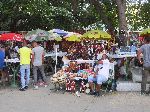 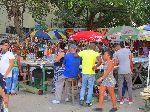 On
the La Rampa side of the Habana Libre is a craft market. It location was
probably selected for the convenience of the tourist, but few of the browsers
appeared to be tourists. Most of the inventory was the kitschiest of tourist
kitsch. 'La Rampa' refers to the northern end of Calle 23. It is a very popular
walk for Habaneros of all ages: it is lined with bars, cafés, and dancing venues
and there are hundreds of hotel and rental rooms in the neighborhood for
tourists.. On
the La Rampa side of the Habana Libre is a craft market. It location was
probably selected for the convenience of the tourist, but few of the browsers
appeared to be tourists. Most of the inventory was the kitschiest of tourist
kitsch. 'La Rampa' refers to the northern end of Calle 23. It is a very popular
walk for Habaneros of all ages: it is lined with bars, cafés, and dancing venues
and there are hundreds of hotel and rental rooms in the neighborhood for
tourists.. |
||
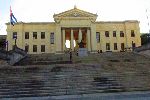
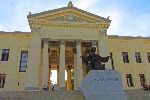
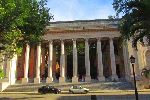
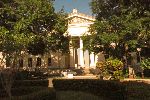
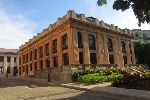 |
||
| The University of Havana, is up the street. It was founded in 1728, and is the oldest university in Cuba, and one of the first to be founded in the Americas. The Vedado campus is dates from the beginning of the 20th century. At the main university entrance, there is a bronze statue of Alma Mater (meaning the "Nourishing mother" in Latin) that was created in 1919 by artist Mario Korbel. The image to the far right is the central library. The middle image is of the College of Math and Computer Science. Other faculties, or schools, of the university are; biology, pharmacy, physics, geography, psychology, chemistry, arts and letters, communications, law, philosophy and history, accounting and finance, economics, tourism and distance education. After the government was taken over by Fulgencio Batista in 1952, the University became a center of anti-government protests. Batista closed the University in 1956. Fidel purged it of anti-revolutionary ideas, before he re-opened it in 1962. | ||
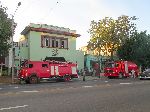 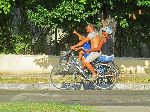 Estación
de Bomberos (fire station) for the Havana Fire Department (left). Estación
de Bomberos (fire station) for the Havana Fire Department (left).Father, mother and son on a bicycle outing (right). |
||
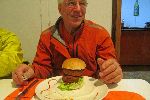
A private restaurant (right), in what was once the driveway to the house. The owners of the restaurant live in the house to the right. |
||
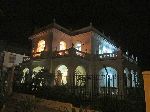 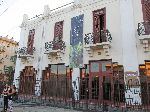 Sevando, Galeria de Arte (left), another source for creative expression on Avenida 23, Vedado. Casa Blanca, at night. It is one of the most elegant houses in Vedado, day or night. (right) |
||
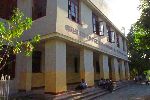 A pre-college
building, covers the level of a college prep, high school in the US. A pre-college
building, covers the level of a college prep, high school in the US. |
||
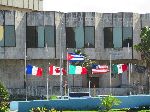
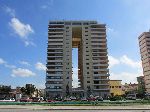
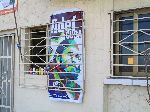 |
||
| Cental
Havana
|
||
    |
||
|
"Hosted by
DreamHost - earth friendly web hosting"
|
||
|
|
|
